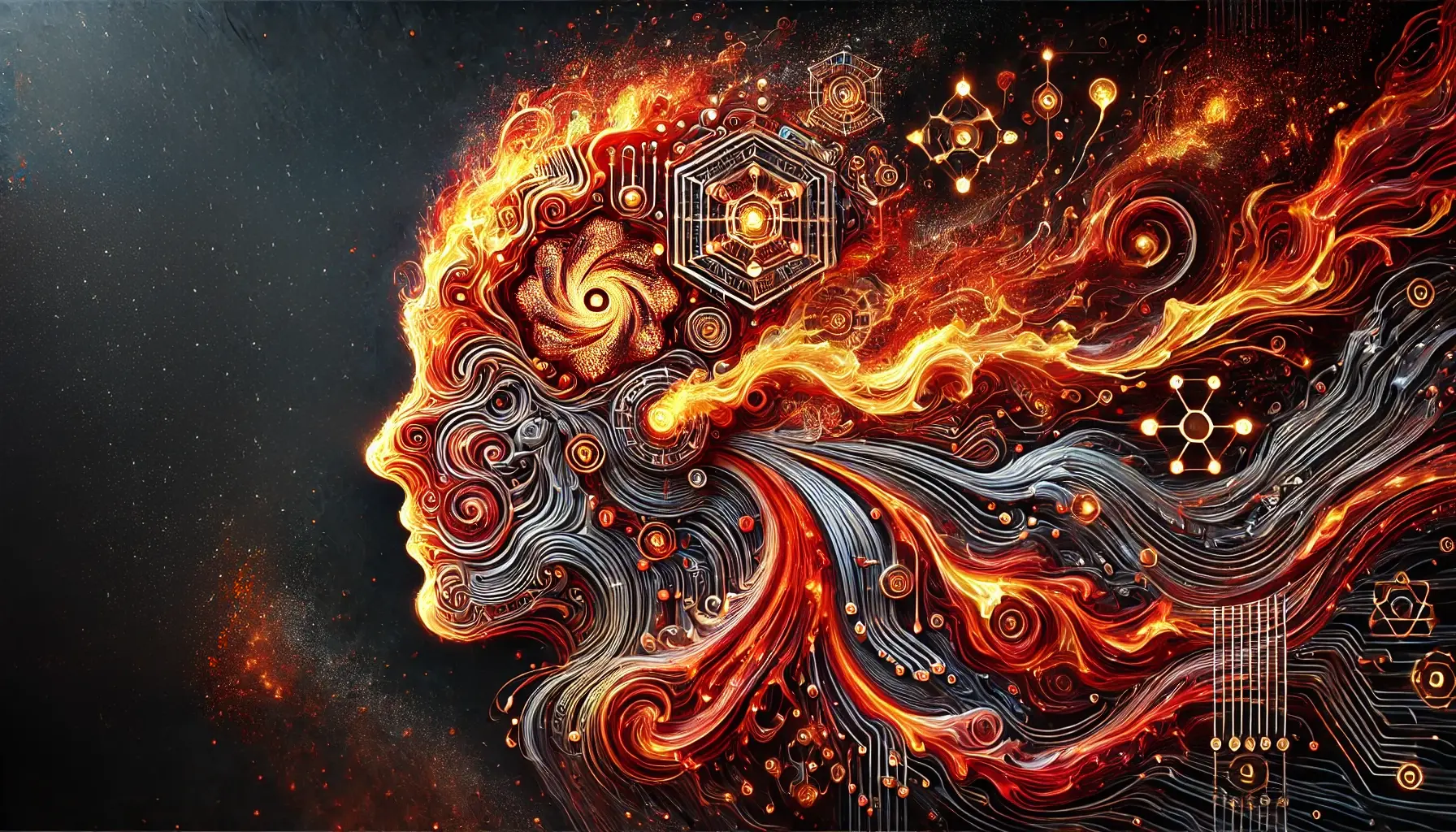
The debate between symbolic AI and deep learning often stirs curiosity. Are these paradigms destined to clash, or can they collaborate to unlock new possibilities? Let’s dive in to explore their strengths, weaknesses, and potential synergy.
What Is Symbolic AI?
The Foundation of Symbolic Reasoning
Symbolic AI, also known as classical AI, relies on explicit rules and representations of knowledge. Think of it as a system that manipulates symbols to solve problems logically.
- How it works: Programmers encode knowledge into structured data and rules, allowing the system to make decisions.
- Example: An expert system in healthcare might use pre-defined medical rules to diagnose illnesses.
Strengths of Symbolic AI
- Transparency: Symbolic systems are highly interpretable, as rules and decisions can be easily traced.
- Precision: Works exceptionally well in domains with well-defined logic, such as legal reasoning or mathematical proofs.
- Knowledge Representation: It excels in scenarios requiring abstract, conceptual understanding.
Weaknesses of Symbolic AI
- Lack of adaptability: It struggles in environments with incomplete or noisy data.
- Limited scalability: Building and maintaining extensive rule sets is labor-intensive and rigid.
Understanding Deep Learning
The Neural Network Revolution
Deep learning, a subset of machine learning, relies on artificial neural networks inspired by the human brain. It’s the powerhouse behind modern AI applications like image recognition, language processing, and autonomous vehicles.
- How it works: Deep learning uses large datasets to train models that can identify patterns and make predictions.
- Example: Facial recognition systems classify images by learning from millions of examples.
Strengths of Deep Learning
- Scalability: Handles vast amounts of data efficiently.
- Adaptability: Learns from unstructured data, making it ideal for complex and dynamic environments.
- Performance: Achieves state-of-the-art accuracy in fields like speech recognition and natural language processing.
Weaknesses of Deep Learning
- Lack of interpretability: Neural networks are often considered “black boxes,” making their decision-making opaque.
- Data dependency: Requires enormous datasets for effective training.
- High resource cost: Training models demands significant computational power and time.
The Competition: A Battle of Paradigms?

Symbolic AI’s Rigidity vs. Deep Learning’s Flexibility
Symbolic AI and deep learning are often viewed as competitors due to their contrasting approaches. While symbolic AI prioritizes logic and structure, deep learning thrives on data-driven inference.
- Symbolic AI’s reliance on rules limits its ability to generalize, especially in noisy environments.
- Deep learning’s reliance on pattern recognition often lacks the conceptual understanding inherent in symbolic systems.
Common Areas of Conflict
- Explainability: Symbolic AI wins in scenarios where transparency is critical, like finance and law.
- Scalability: Deep learning dominates in fast-paced industries like social media and entertainment.
Misaligned Objectives
Symbolic AI excels in structured domains, whereas deep learning thrives in chaotic, real-world applications. This divergence has led to a perception of rivalry.
The Case for Cooperation: Combining Strengths
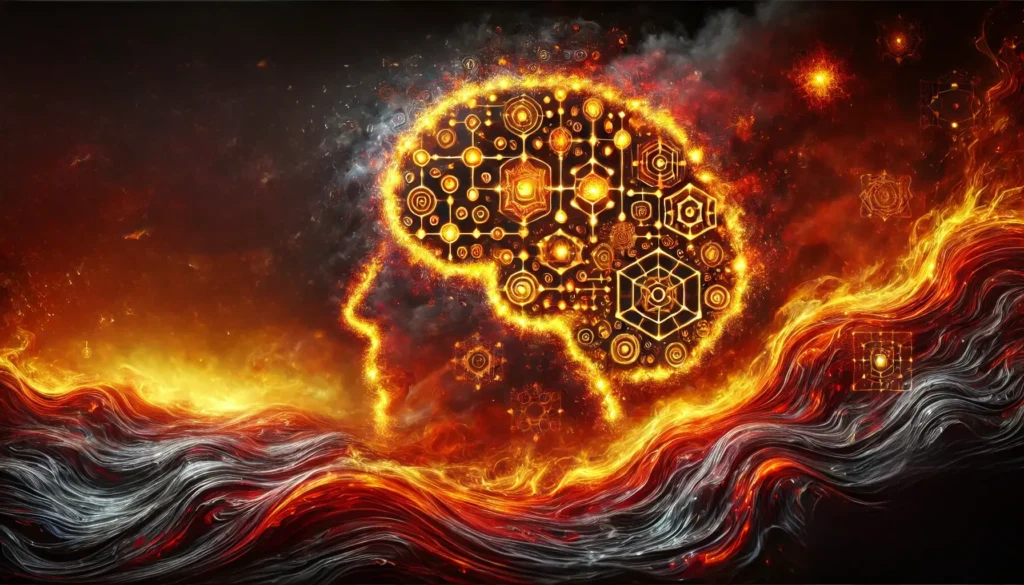
Hybrid AI Models: The Best of Both Worlds
Rather than competing, symbolic AI and deep learning can complement each other, creating systems that combine logic with learning. This approach, often referred to as neuro-symbolic AI, integrates symbolic reasoning into deep learning architectures.
- How it works: Deep learning handles data processing and pattern recognition, while symbolic AI applies logical reasoning and rule-based decision-making.
- Example: A hybrid AI in robotics can use deep learning for visual perception and symbolic reasoning for task execution.
Benefits of Hybrid AI
- Enhanced interpretability: The symbolic layer provides clear explanations for decisions made by the deep learning model.
- Improved efficiency: Reduces the need for enormous datasets by incorporating symbolic rules.
- Real-world applicability: Works well in complex domains, such as autonomous driving or medical diagnostics, where both reasoning and adaptability are crucial.
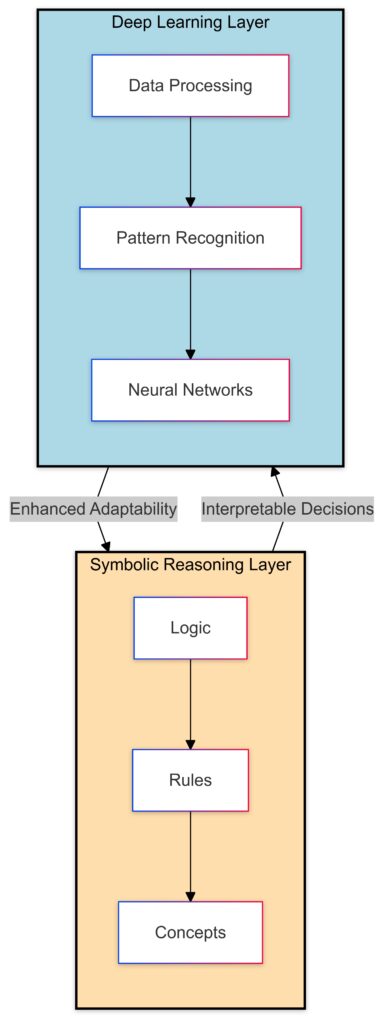
How hybrid AI combines symbolic reasoning with deep learning to enhance decision-making and adaptability.
Emerging Use Cases
- Healthcare: Deep learning identifies patterns in medical images, while symbolic AI applies diagnostic rules.
- Legal Tech: Symbolic AI ensures compliance with regulations, while deep learning processes contracts and legal documents.
- Natural Language Understanding: Combining symbolic grammar rules with neural language models improves context comprehension.
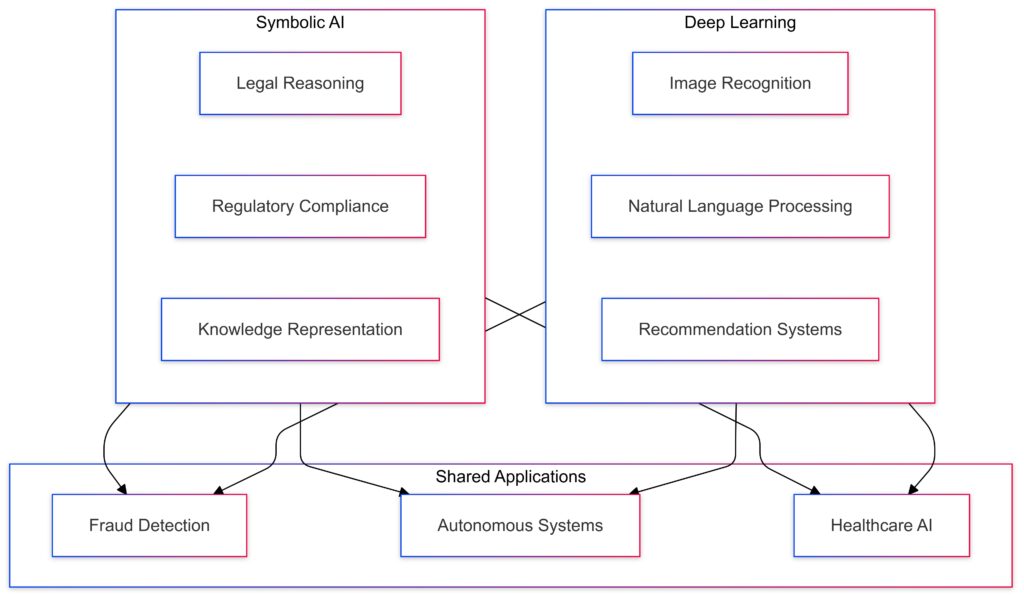
Legal Reasoning: Interpreting legal documents and statutes.
Regulatory Compliance: Ensuring adherence to rules and guidelines.
Knowledge Representation: Structuring domain-specific knowledge for inference.
Deep Learning:
Image Recognition: Processing and understanding visual data.
Natural Language Processing: Understanding and generating human language.
Recommendation Systems: Personalizing content for users.
Shared Applications:
Fraud Detection: Identifying anomalies in financial transactions.
Autonomous Systems: Enabling vehicles and robots to make decisions.
Healthcare AI: Supporting diagnosis and treatment planning.
Challenges in Collaboration
Bridging the Paradigms
While hybrid AI holds promise, integration is no small feat. Symbolic AI and deep learning operate on fundamentally different principles.
- Technical complexity: Creating seamless interactions between symbolic reasoning and neural networks requires sophisticated engineering.
- Data integration: Combining structured and unstructured data into a unified framework can be challenging.
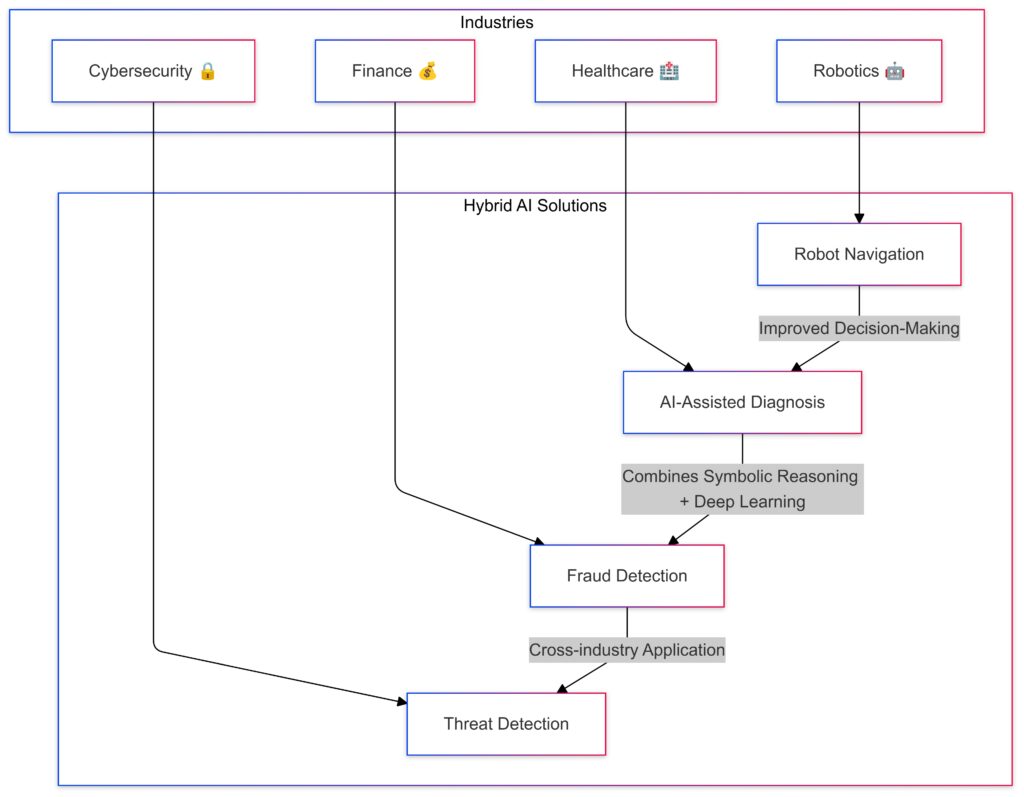
Overcoming Skepticism
The AI community often debates whether one paradigm will eventually dominate. Advocating for hybrid models requires shifting mindsets toward collaboration.
- Education: Promoting understanding of both paradigms can foster appreciation for their complementary strengths.
- Research focus: Funding interdisciplinary projects will accelerate innovation in hybrid AI.
The Future of AI: Cooperation Over Competition?
The Rise of Explainable AI (XAI)
As the demand for explainability grows, combining symbolic AI’s transparency with deep learning’s capabilities becomes increasingly attractive. Industries like healthcare, finance, and law require AI solutions that are both powerful and understandable.
The Road Ahead
- Continued research in neuro-symbolic AI will likely redefine how we approach AI development.
- Companies and academic institutions are already investing in hybrid models to address real-world challenges.
By moving past rivalry and embracing cooperation, symbolic AI and deep learning can unlock the next wave of innovation in artificial intelligence. Together, they offer a path toward systems that are smarter, fairer, and more effective than either paradigm alone.
Bridging Symbolic AI and Deep Learning in Practice
Current Efforts in Neuro-Symbolic AI
Several organizations and research teams are already exploring how symbolic AI and deep learning can work together. These efforts aim to merge the interpretability of symbolic systems with the adaptability of neural networks.
- IBM’s Project Debater: Combines natural language processing (NLP) with symbolic reasoning to understand arguments and counterarguments in debates.
- MIT-IBM Watson AI Lab: Focuses on integrating deep learning with symbolic logic to solve complex reasoning tasks, such as algebra and visual question answering.
These initiatives highlight the potential for hybrid models to tackle challenges that neither paradigm can solve alone.
Practical Applications of Hybrid AI
The fusion of symbolic AI and deep learning is making its mark across various industries:
- Education: AI tutors can use symbolic reasoning to explain complex concepts, while deep learning personalizes learning paths for students.
- Supply Chain Management: Symbolic rules optimize inventory management, while neural networks predict demand trends using big data.
- Cybersecurity: Neural networks detect anomalies in network traffic, and symbolic AI enforces compliance with security policies.
Tools and Frameworks Driving Integration
Developers and researchers now have access to tools that simplify the creation of hybrid AI systems:
- Neuro-symbolic reasoning frameworks: Platforms like Logical Neural Networks (LNNs) combine neural learning with logical rules.
- Knowledge graphs: Deep learning models can leverage knowledge graphs to contextualize information, making decisions more interpretable.
The Philosophical Angle: Cooperation for Intelligence
Symbolism, Connectionism, and the Quest for AGI
In the pursuit of artificial general intelligence (AGI), blending symbolic and connectionist approaches may hold the key. AGI requires both data-driven intuition and logical reasoning—a balance that neuro-symbolic AI strives to achieve.
- Symbolic AI represents explicit knowledge: facts, rules, and structured logic.
- Deep learning embodies implicit knowledge: learned patterns and unstructured insights.
Together, they mimic human intelligence, which seamlessly blends logic with intuition.
Ethical and Social Implications
Combining symbolic AI and deep learning could address pressing ethical challenges:
- Bias mitigation: Symbolic reasoning introduces fairness constraints, reducing biases in deep learning models.
- Transparency: Hybrid AI systems are better suited to meet regulatory demands for explainability in high-stakes applications like criminal justice and healthcare.
Challenges to Hybrid AI Adoption
Technical and Cultural Barriers
Despite the promise of cooperation, there are hurdles to overcome:
- Integration costs: Building hybrid systems requires investment in expertise and infrastructure.
- Cultural silos: Researchers in symbolic AI and deep learning often work independently, limiting collaboration.
Building Bridges in Research and Development
To overcome these barriers, fostering interdisciplinary collaboration is essential. Conferences, workshops, and joint funding opportunities can encourage shared innovation.
Conclusion: A Future Built on Collaboration
The relationship between symbolic AI and deep learning doesn’t have to be a competition. Instead, it’s a partnership where each paradigm fills the other’s gaps. By working together, these approaches can revolutionize industries, solve complex problems, and push AI closer to achieving its full potential.
The question isn’t whether they will cooperate—it’s how soon.
FAQs
What is the main difference between symbolic AI and deep learning?
The core distinction lies in their approach to problem-solving:
- Symbolic AI relies on predefined rules and logic to make decisions. For example, an expert system diagnosing diseases based on specific medical symptoms follows programmed if-then rules.
- Deep learning, on the other hand, learns patterns from data. Think of a neural network analyzing thousands of chest X-rays to identify pneumonia—it doesn’t rely on explicit rules but on what it “learns” from the data.
Can symbolic AI and deep learning work together?
Yes, they can complement each other through hybrid or neuro-symbolic AI systems. For instance, an autonomous car might use deep learning for real-time object detection (like identifying pedestrians) and symbolic reasoning for rule-based decisions (like stopping at a red light). This combination ensures both flexibility and logical consistency.
Which is better for tasks requiring explainability?
Symbolic AI is generally better for tasks that demand transparency because its rules are explicit and easy to trace. For example, in the legal industry, a symbolic AI system can explain how it reached a conclusion based on established laws.
In contrast, deep learning models often act as “black boxes,” making their decisions harder to interpret.
Is symbolic AI outdated compared to deep learning?
Not at all. While deep learning has dominated recent AI advancements, symbolic AI remains valuable in fields requiring logical precision and interpretability. For example:
- Tax software uses symbolic AI to calculate deductions based on specific laws.
- Symbolic AI also plays a crucial role in creating knowledge graphs, which are used in search engines to improve query understanding.
How does hybrid AI improve real-world applications?
Hybrid AI combines the strengths of symbolic reasoning and deep learning to address complex challenges. For example:
- In healthcare, a hybrid AI can analyze medical scans using deep learning while applying symbolic reasoning for diagnosis based on patient history.
- In finance, a hybrid system might detect fraudulent transactions with deep learning and then validate decisions using regulatory compliance rules encoded in symbolic AI.
Are there tools to help integrate symbolic AI and deep learning?
Yes, several frameworks and tools are making hybrid AI more accessible. For example:
- Logical Neural Networks (LNNs): Combine symbolic logic and neural network capabilities.
- Knowledge Graphs: Enable deep learning models to incorporate structured information for better contextual reasoning.
These tools make it easier for developers to build systems that balance data-driven insights with logical precision.
What are the challenges of adopting hybrid AI?
Some common hurdles include:
- Technical complexity: Designing systems that seamlessly combine the two paradigms requires advanced engineering expertise.
- Data integration: Symbolic AI often deals with structured data, while deep learning thrives on unstructured data. Merging these formats can be tricky.
- Cost: Building hybrid systems may require significant computational and human resources.
How does hybrid AI impact ethical AI development?
Hybrid AI can help address critical ethical concerns:
- Bias reduction: Symbolic rules can enforce fairness constraints, ensuring that decisions align with ethical principles.
- Explainability: By combining interpretable symbolic reasoning with neural networks, hybrid AI improves transparency, particularly in sensitive applications like criminal justice or hiring.
Will hybrid AI lead to AGI?
Hybrid AI is seen as a step toward artificial general intelligence (AGI) because it mimics human intelligence more closely than either paradigm alone. Humans use both logical reasoning (akin to symbolic AI) and pattern recognition (similar to deep learning) to solve problems. For example, understanding a legal case involves interpreting laws (symbolic reasoning) and recognizing patterns in evidence (deep learning).
How do symbolic AI and deep learning approach problem-solving differently?
Symbolic AI uses rule-based algorithms to follow explicit instructions, like solving a math equation step-by-step. Deep learning, however, identifies patterns and makes predictions based on training data.
Example comparison:
- A symbolic AI program for chess evaluates moves using logical heuristics and defined strategies.
- A deep learning chess engine, like AlphaZero, learns to play by analyzing millions of games and adapting over time.
Are hybrid AI systems expensive to implement?
Yes, they can be resource-intensive, but the long-term benefits often outweigh the costs. For instance:
- Training costs: Deep learning models need large datasets and significant computational power.
- Development complexity: Integrating symbolic AI into deep learning workflows requires skilled teams and advanced frameworks.
However, industries like autonomous driving or financial analysis justify these expenses by achieving better accuracy, efficiency, and regulatory compliance.
Can hybrid AI systems adapt to new scenarios like deep learning?
Hybrid systems balance adaptability and structured reasoning:
- The deep learning component enables them to learn and generalize from data, such as recognizing trends in financial markets.
- The symbolic AI layer ensures adaptability by updating rules based on new policies or conditions, such as changes in tax regulations.
This dual capability makes them highly versatile in dynamic environments.
How does hybrid AI enhance decision-making?
By combining symbolic reasoning and deep learning, hybrid AI enables smarter decision-making in complex scenarios. For instance:
- Example in fraud detection:
- A deep learning model identifies suspicious patterns in financial transactions.
- Symbolic AI cross-checks the flagged transactions against predefined fraud rules, ensuring accuracy.
This layered approach reduces false positives while maintaining trustworthiness.
How are startups leveraging hybrid AI?
Many startups are pioneering neuro-symbolic AI to innovate across industries:
- Sana Labs: Uses hybrid AI to personalize corporate training by combining content recommendation (deep learning) with structured curriculum planning (symbolic AI).
- Cortical.io: Applies symbolic reasoning and neural networks to extract meaning from complex legal documents.
These startups demonstrate that hybrid AI is not only for large corporations but also for agile innovators.
Will hybrid AI become the dominant paradigm?
It’s likely that hybrid AI will gain more traction as industries seek more explainable, versatile, and accurate AI systems. However, adoption depends on advancements in technology and a shift in mindset toward interdisciplinary collaboration.
For instance:
- As governments mandate AI explainability (e.g., in GDPR), hybrid AI may become essential for compliance.
- Research into neuro-symbolic AI could accelerate breakthroughs in fields like education, governance, and creativity, making hybrid systems the norm.
How does hybrid AI manage data diversity?
Hybrid AI bridges the gap between structured and unstructured data:
- Symbolic AI excels at processing structured data like databases or spreadsheets, which have clear hierarchies and categories.
- Deep learning shines with unstructured data like text, images, or audio.
A hybrid system can process an insurance claim by extracting context from text (deep learning) and validating details against structured rules (symbolic AI).
This dual approach ensures a broader range of data sources can be utilized effectively.
What role does hybrid AI play in robotics?
In robotics, hybrid AI allows machines to reason logically and adapt to their environment:
- Symbolic AI can guide task planning, such as assembling components in a factory or navigating defined paths.
- Deep learning handles perception, like recognizing objects in real-time or interpreting sensor data.
For instance, a warehouse robot may use deep learning to identify boxes of varying sizes and symbolic AI to follow rules for organizing them efficiently.
Are hybrid AI systems more energy-efficient?
In some cases, yes. While deep learning models are resource-intensive to train and operate, hybrid AI can optimize efficiency:
- Symbolic AI requires less computational power to perform logical reasoning tasks.
- Hybrid systems can offload simple tasks to the symbolic layer, reducing reliance on energy-hungry neural networks.
For example, a hybrid AI in energy grid management might use symbolic rules for routine scheduling and deploy deep learning only for complex predictions, such as peak usage patterns.
How does hybrid AI impact natural language understanding (NLU)?
Hybrid AI improves NLU by combining symbolic grammar rules with deep learning’s contextual understanding:
- Deep learning models (like transformers) identify patterns in language and predict context.
- Symbolic reasoning ensures grammatical accuracy and enforces logical relationships.
For instance, a legal AI assistant could use deep learning to summarize lengthy contracts and symbolic AI to ensure clauses adhere to specified regulations.
What are the potential risks of hybrid AI systems?
Despite their advantages, hybrid AI systems come with challenges:
- Complexity: Designing, deploying, and maintaining hybrid systems is more intricate than using either symbolic AI or deep learning alone.
- Integration challenges: Merging two fundamentally different paradigms can lead to inconsistencies if not carefully managed.
- Ethical risks: While hybrid AI can reduce biases, errors in the symbolic rules or training data can still propagate through the system.
For example, a bias in the deep learning component might go unchecked if the symbolic layer lacks oversight mechanisms.
What skills are needed to develop hybrid AI?
Building hybrid AI systems requires expertise in both paradigms:
- Symbolic AI skills: Knowledge of logic programming, rule-based systems, and ontology development.
- Deep learning skills: Proficiency in neural networks, data preprocessing, and framework usage (e.g., TensorFlow, PyTorch).
- Integration expertise: Skills in hybrid frameworks like Logical Neural Networks (LNNs) or hybrid NLP tools.
Developers also need interdisciplinary knowledge, such as domain expertise in healthcare or law, to design systems suited to specific applications.
How does hybrid AI impact real-time decision-making?
Hybrid AI is well-suited for real-time applications that require both fast pattern recognition and logical consistency. For example:
- In autonomous vehicles, deep learning detects pedestrians or traffic signs, while symbolic AI ensures adherence to traffic rules, like speed limits or no-parking zones.
- In cybersecurity, deep learning detects unusual network activity, while symbolic AI applies logic to classify the severity of potential threats and recommend actions.
This combination ensures timely, accurate, and compliant decisions in high-stakes environments.
Can hybrid AI adapt as regulations evolve?
Yes, hybrid AI systems are particularly effective at adapting to regulatory changes:
- Symbolic AI can update rulesets to reflect new laws or policies.
- Deep learning continually improves its pattern recognition capabilities to align with emerging trends in data.
For example, a fintech application might use symbolic AI to incorporate changes in tax laws, while deep learning analyzes shifting market conditions to guide investment strategies.
Resources
Research Papers
- Neuro-symbolic Architectures for Context Understanding by Alessandro Oltramari et al.
Discusses combining neural networks and symbolic reasoning for enhanced context understanding in AI systems. - Neurosymbolic AI — Why, What, and How by Amit Sheth, Kaushik Roy, and Manas Gaur
Explores the motivations, methodologies, and applications of integrating neural and symbolic AI approaches. - Dual Embodied-Symbolic Concept Representations for Deep Learning by Daniel T. Chang
Advocates for a dual-level model combining embodied and symbolic concept representations in deep learning.
Web Articles and Blogs
- Neuro-Symbolic AI: Merging Deep Learning & Logic
An overview of how combining symbolic reasoning with deep learning can lead to more robust AI systems. AI Kompetenz - Symbolic AI vs. Deep Learning: Key Differences and Their Roles in AI Development
A comparative analysis of symbolic AI and deep learning, highlighting their unique strengths and applications. Smythos - Combining Symbolic AI with Generative Neural Networks
Discusses the integration of symbolic AI with generative neural networks to create hybrid models. Xcube Labs
Podcasts and Interviews
- Gary Marcus: Toward a Hybrid of Deep Learning and Symbolic AI (Lex Fridman Podcast)
Gary Marcus delves into the evolution of AI, advocating for a hybrid approach that integrates symbolic reasoning with deep learning. Huberman Lab AI - The Case for Hybrid Artificial Intelligence (TechTalks)
An interview discussing the benefits and challenges of combining neural networks with symbolic AI. Bd Tech Talks
Academic Courses and Lectures
- Neural-Symbolic Learning and Reasoning (Workshop Series)
A series of workshops focusing on the integration of neural networks and symbolic reasoning in AI. - Hybrid AI Models: Integrating Symbolic Reasoning with Deep Learning
An academic paper discussing frameworks that combine symbolic reasoning with deep learning for complex decision-making. Jetir
These resources offer a comprehensive foundation for understanding the distinct and combined aspects of symbolic AI and deep learning, guiding you through the evolving landscape of hybrid AI systems.